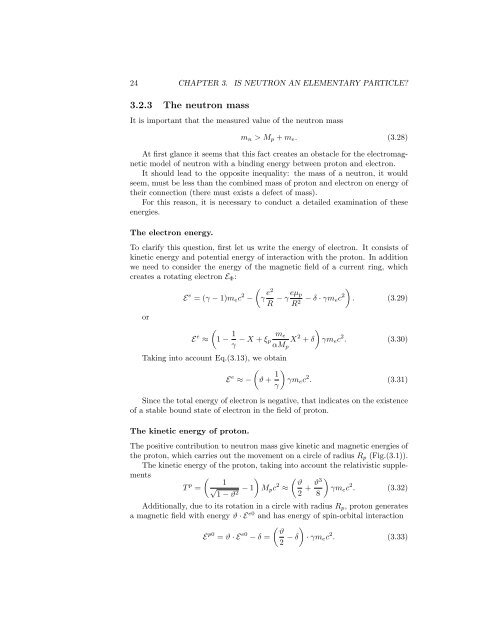VbvNeuE-001
Boris V. Vasiliev About Quantum-Mechanical Nature of Nuclear Forces and Electromagnetic Nature of Neutrinos
Boris V. Vasiliev
About Quantum-Mechanical Nature of Nuclear Forces
and Electromagnetic Nature of Neutrinos
You also want an ePaper? Increase the reach of your titles
YUMPU automatically turns print PDFs into web optimized ePapers that Google loves.
24 CHAPTER 3. IS NEUTRON AN ELEMENTARY PARTICLE?<br />
3.2.3 The neutron mass<br />
It is important that the measured value of the neutron mass<br />
m n > M p + m e . (3.28)<br />
At first glance it seems that this fact creates an obstacle for the electromagnetic<br />
model of neutron with a binding energy between proton and electron.<br />
It should lead to the opposite inequality: the mass of a neutron, it would<br />
seem, must be less than the combined mass of proton and electron on energy of<br />
their connection (there must exists a defect of mass).<br />
For this reason, it is necessary to conduct a detailed examination of these<br />
energies.<br />
The electron energy.<br />
To clarify this question, first let us write the energy of electron. It consists of<br />
kinetic energy and potential energy of interaction with the proton. In addition<br />
we need to consider the energy of the magnetic field of a current ring, which<br />
creates a rotating electron E Φ :<br />
E e = (γ − 1)m e c 2 −<br />
(γ e2<br />
R − γ eµ )<br />
p<br />
R 2 − δ · γm ec 2 . (3.29)<br />
or<br />
(<br />
E e ≈ 1 − 1 )<br />
γ − X + ξ m e<br />
p X 2 + δ γm e c 2 . (3.30)<br />
αM p<br />
Taking into account Eq.(3.13), we obtain<br />
(<br />
E e ≈ − ϑ + 1 )<br />
γm e c 2 . (3.31)<br />
γ<br />
Since the total energy of electron is negative, that indicates on the existence<br />
of a stable bound state of electron in the field of proton.<br />
The kinetic energy of proton.<br />
The positive contribution to neutron mass give kinetic and magnetic energies of<br />
the proton, which carries out the movement on a circle of radius R p (Fig.(3.1)).<br />
The kinetic energy of the proton, taking into account the relativistic supplements<br />
(<br />
)<br />
T p 1<br />
= √ − 1 M p c 2 ≈<br />
1 − ϑ<br />
2<br />
( ϑ<br />
2 + ϑ3<br />
8<br />
)<br />
γm e c 2 . (3.32)<br />
Additionally, due to its rotation in a circle with radius R p , proton generates<br />
a magnetic field with energy ϑ · E e0 and has energy of spin-orbital interaction<br />
( ) ϑ<br />
E p0 = ϑ · E e0 − δ =<br />
2 − δ · γm e c 2 . (3.33)












